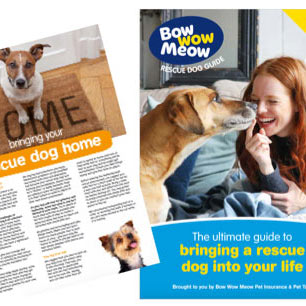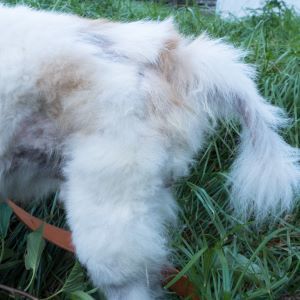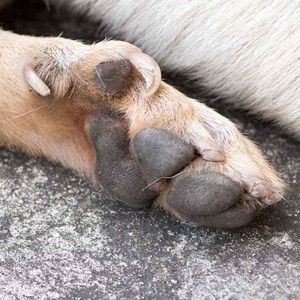Nail disorder and torn nails in dogs and cats
What is nail disorder / torn nail?
The curved, pointed, horny nails that grow on the end of each toe of cats and dogs are usually referred to as “claws”. As carnivorous mammals, their claws are used for catching and holding prey, digging, climbing trees, self-defence and grooming.
The outer layer of the claw is made from a hardened form of the epidermis, or skin, called keratin. This tough, horny material surrounds and protects the sensitive inner structures, termed the “quick”, consisting of blood vessels and nerves. Keratin is not living tissue and can be torn or cut without causing pain. However, the quick is living tissue, which is why exposing the quick is usually very painful.
Cat claws vs dog claws
The cat’s claw is more highly adapted and complex than the dog’s. Feline claws are very sharp and curved, which facilitates grasping prey while hunting, as well as slashing a rival during a fight over territory. The cat’s claws are retractable; therefore, they do not get in the way or make noise while walking or running. Cats often scratch or knead furniture, bedding, curtains and other objects to remove the outer layers of the front claws and keep them sharp.
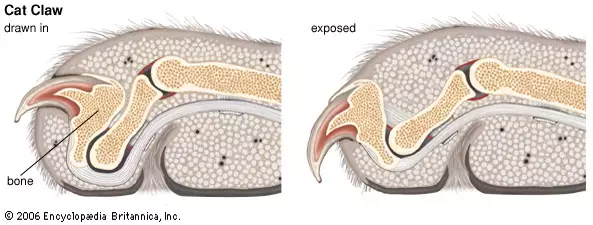
Cat Nail; Cat Claw. Nail disorder / torn nail in cats
Source: https://cdn.britannica.com/56/93056-004-C6DF52F7.jpg
A nail disorder refers to any problem or abnormality affecting the nail or nail bed. Several disorders can affect a dog or cat’s nails, and each of these can have serious and painful effects on the animal. While a torn nail is a common nail issue, there are also several pathogens that can affect the claws, such as bacterial and fungal infections. Other common nail conditions include extremely brittle nails (onychorrhexis) and nails that separate, peel, and slough excessively (onychomadesis).
A nail condition may not be a stand-alone disorder. For example, as the nail is a continuation of the epidermis and dermis (layers of the skin), a bacterial infection of the nail can occur along with a skin condition. Systemic diseases can also affect the claws and nails.
Torn nail
Even a small tear of a single nail can cause significant pain for a dog or cat. Because of the high supply of blood to the base of the nail (the quick), ongoing or intermittent bleeding can occur. If the tear is left as an open wound, an infection can develop, causing more serious problems. Kittens are particularly prone to torn nails because of their high energy and extremely delicate claws. Veterinary attention is needed to ensure the wound heals correctly.
Paronychia
Paronychia is an infection of the nail bed and/or the tissue around the nail, where the nail and skin meet. Infection can occur in one or multiple claws. The infection may be bacterial or fungal, although bacterial infections usually occur secondary to trauma to the area.
Onychomycosis
This is a fungal infection that occurs in and around the nail bed. Infection can occur in one or multiple claws. The most common agents are ringworm and malassezia, a yeast overgrowth.
Symptoms of nail disorder / torn nail
A nail or claw disorder can be very painful and the animal’s ability to walk may be affected.
Symptoms of a torn nail include the following:
- Drops of blood around the home, as a torn nail may bleed sporadically for hours
- Excessive paw licking and biting
- Crying, yelping or whining
- Jagged appearance of claw
- Bloody paw
- Limping
- Holding up the foot
- Pain when affected paw is touched
- Swollen paw
- Difficulty walking
Symptoms of nail infection depend on the pathogen involved. Infection can occur in one or multiple claws, and symptoms may include:
- Claw pain (onychalgia)
- Discolouration of the nail
- Pus
- Crusting
- Lameness
- Swelling and inflammation around the nails
- Licking or fussing at the paws
- Disfigured claws
- Flaking
- Itching
- Brownish discolouration and greasy discharge (in cases of malassezia)
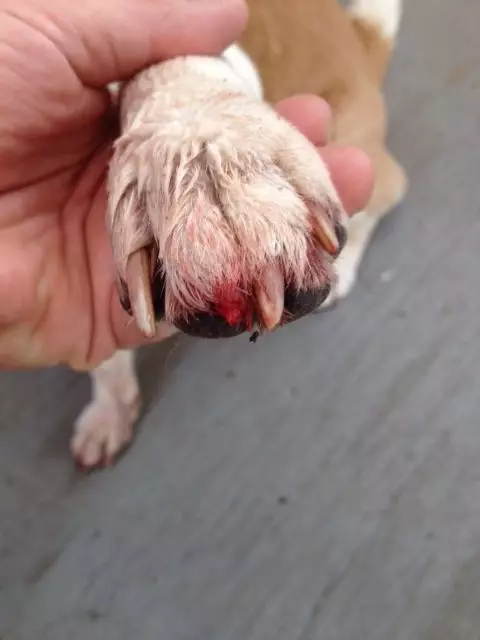
Source: https://blog.propethero.com/wp-content/uploads/2017/04/Riatoe-e1491398862587.jpg
Causes of nail disorder / torn nail
Diseases and abnormalities of the nail and claw are quite numerous in nature and often accompany skin disorders.
Nail disorders in cats may be caused by:
- Most commonly, a bacterial or fungal infection, in or around the nail bed
- Trauma to the nail
- Infection secondary to immune-mediated or systemic illnesses such as FIV or FeLV, diabetes, Cushing’s disease (hyperadrenocorticism) and use of steroids
- High levels of growth hormone
- Disorders present at birth (congenital)
- Cutting the nails too close to the nail bed, excessive trimming, nail chewing, ingrown nails or declawing, making them susceptible to infection
- Cancer or tumours
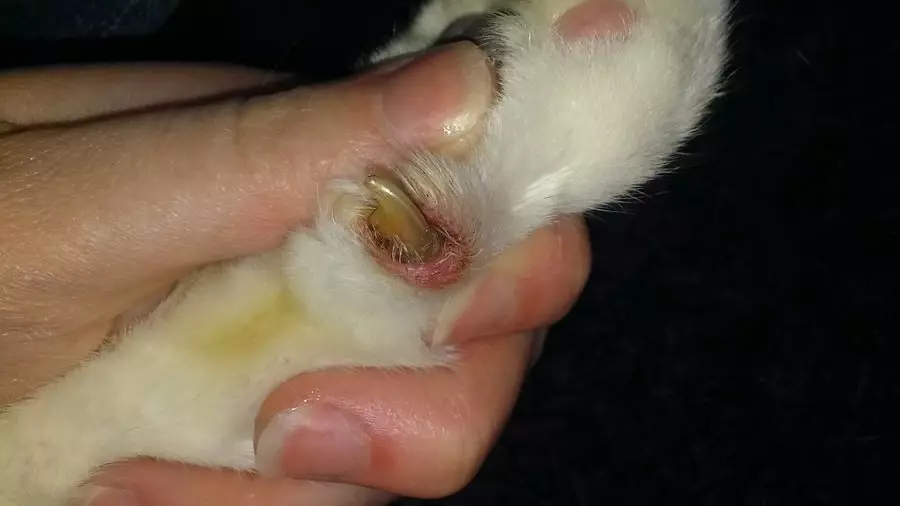
Source: https://thecatsite.com/threads/infected-claw.254429/
Nail disorders in dogs may be caused by:
- Environmental factors, e.g. excessive humidity or dryness
- Poor nail clipping techniques
- Viruses, e.g. distemper
- Bacterial or fungal infection
- Infection secondary to immune-mediated or systemic illnesses such as hypoadrenocorticism, diabetes, pemphigus vulgaris
- Trauma to the nail
- Cancer or tumours
- Old age
- Poor nutrition
- Breed disposition – King Charles Spaniel, American Cocker Spaniel and German Shepherds are prone to nail disorders
Torn nails in both dogs and cats are commonly caused by:
- Irregular or poor trimming and/or grooming of the nails, resulting in overly long and sharp claws which can easily snag on carpets, furniture etc.
- An outdoor lifestyle, for example, snagging the nails when climbing trees or while running
- A traumatic injury to the claw, for example, from a car accident or vigorous play
- Landing badly on the claw when jumping up to, or down from, a high place, causing it to bend backwards or break
- Excessive scratching of carpets, scratching post materials, etc
- Having dry and brittle nails, especially in older pets
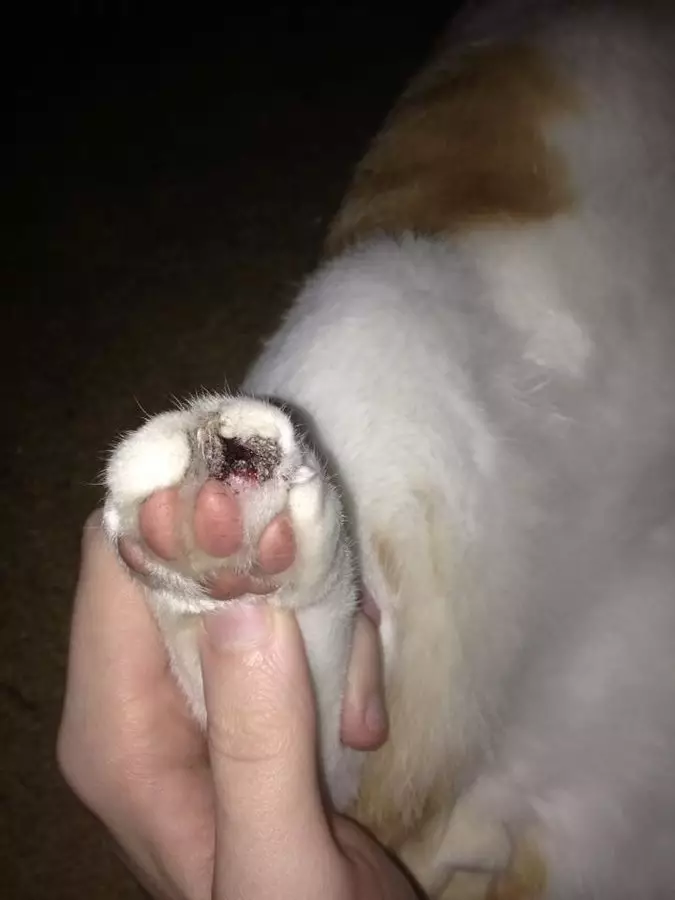
Source: https://thecatsite.com/threads/cat-tore-his-toenail-skin-off.334502/
How is nail disorder / torn nail diagnosed?
While nail disorders may appear relatively minor, they can be caused by serious infections or in rare cases, cancer. For this reason, it is vital that the cat or dog be examined by the veterinarian in order to diagnose the underlying cause of the nail disorder. The veterinarian will perform a physical examination, obtain a medical history and undertake additional tests if necessary.
Medical history
Providing the animal’s medical history will help to determine if the issue is congenital (caused at birth) or is secondary to another health issue. You should inform the veterinarian if the nails have recently been trimmed, as this is a common cause of infection when not performed correctly.
Physical examination
The vet will examine the problematic nail for a tear and/or signs of infection such as inflammation, seeping blood or oozing pus. The other nails will also be examined; if multiple nails are affected, it could indicate a serious medical condition. If the animal has suffered a trauma, the vet will identify and treat any other injuries sustained.
Additional diagnostic tests may include
- Baseline tests such as a biochemical analysis, complete blood count and urinalysis – to evaluate the overall health of the cat
- Skin and nail scrapings – to identify conditions such as mites
- Cytology – a sample of cells is obtained and examined under a microscopic to determine the organism involved – bacterial and fungal infections, neoplasia (abnormal tissue growth) and paronychia (inflammation of the soft tissue around the claw) can be identified
- Culture and sensitivity testing – to determine the strain of bacteria involved and the most suitable antibiotic
- Tests such as FIV and FeLV (for cats) and diabetes to determine if there is an underlying illness that is causing the infection
- Radiography of the claws
- Biopsy of the nail
Prognosis
The prognosis for recovery from most nail disorders is excellent, especially of no infection develops. With appropriate treatment, most infections can be successfully resolved in a relatively short time. If the nail is removed, a new nail will grow back within several months.
Treatment for nail disorder / torn nail
Treatment of the nail disorder will depend upon the cause of the problem. In most cases, treatment entailing topical medication and/or minor surgery will resolve the problem. While these solutions are relatively easy and non-invasive, more serious treatment may be required in some cases.
Medical management
- If the nail is torn, any bleeding will be stopped and the nail disinfected. The hanging portion of the nail may be removed with a nail clipper.
- In cases of bacterial or fungal infections, topical ointments can be applied directly to the nail for a period of 2-4 weeks, after which time the cat should return to normal.
- If a bacterial infection is present, or for the prevention of a bacterial infection occurring, an antibiotic will be prescribed. Be sure to administer all antibiotics as instructed.
- Antimicrobial soaks can be effective for reducing inflammation and facilitating healing.
- Pain medication may be prescribed where the quick (the tender live tissue, including blood vessels and nerves) is exposed and causing pain, or an injection may be given.
- Supplements such as Omega 3, vitamin A and vitamin E may be recommended.
- If an underlying immune disorder or other disease is present, medications may be prescribed to treat or manage these conditions.
Surgery
If the skin under or around the nail has become inflamed, the nail plate (the hard portion) may need to be surgically removed in order to allow the tissue to drain and return to normal, lessening the chance of infection. This is a relatively minor procedure that can be performed without sedation or under mild sedation with low risk. The paw may require bandaging until the bleeding stops, and the wound should heal within 2 weeks post-surgery, once the nail regrows.
Ongoing management
- Keep the wound clean by changing bandages regularly and monitoring the injury for signs of infection, such as swelling or redness.
- After the bandage is removed, wash the paw regularly until healing is complete.
- Prevent the animal from licking or biting at its paw. An Elizabethan collar may be needed to ensure the cat leaves the wound alone.
- Canine nails can take up to 9 months to completely grow back, and extra care should be taken until this occurs.
- Continue to monitor the nails after treatment, as recurring issues may point to a more serious problem. If the nail disorder returns, it is essential to consult the veterinarian as soon as possible.
- To avoid torn nails, trim the nails frequently; short nails are less likely to split or break than long ones. Nail clipping is usually easier in cats than in dogs, although caution must be used to avoid cutting the central “quick,” which is the blood supply to the growing nail. Avoid cutting the nails too closely; the skin can be nicked, leaving small cuts which can become infected when doing everyday tasks like exploring and using the litter box.
- Providing cats with a scratching post can also greatly help to keep their nails from overgrowing.
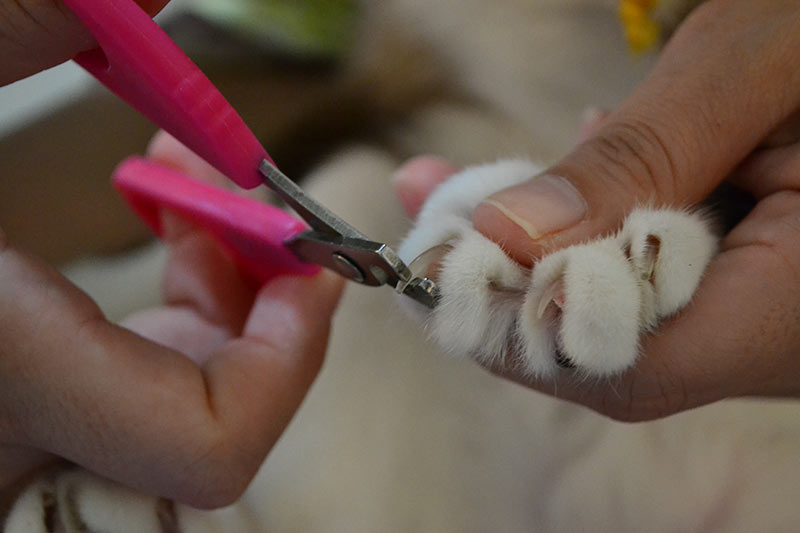
In summary
Nail disorders refer to any abnormality or disease that affects the nails or the surrounding area. A torn nail is a common problem that can cause pain, bleeding and difficulty walking and can lead to an infection if left untreated. Torn nails are often the result of infrequent or incorrect nail trimming, leading to snagging of the nail while climbing, running or playing. Poor nail cutting technique can also expose the tender “quick” and cause pain and inflammation, which can result in infection.
Nail disorders in dogs and cats can also occur as the result of a trauma or a bacterial or fungal infection. They can arise in conjunction with a skin disease or secondary to an immune-mediated or systemic disease. Therefore, it is important to consult the vet in order to identify any underlying conditions and to embark on the appropriate course of treatment.
Most nail or nail bed disorders have an excellent prognosis and, with proper treatment, can be remedied in a relatively short amount of time. Treatment usually entails medical management and/or minor surgery to remove the nail or part of the nail.
Bow Wow Meow Pet Insurance can help protect you and your pet should an unexpected trip to your vet occur.
- Find out more about our dog insurance options
- Find out more about our cat insurance options
- Get an instant online pet insurance quote
Bow Wow Meow is proud to have been awarded winner of Canstar’s ‘Most Satisfied Customers’ Award in the Pet Insurance category for both 2024 and 2025!
Bow Wow Meow is proud to have been chosen as Product Review’s Pet Insurance Award Winner every year from 2018 to 2025! This is based on 2,995 independent customer reviews (as at 21/01/2025), with an overall rating of 4.3*
Google Review rating = 4.5* (based on 968 reviews)
Trust Pilot rating = 4.6* (based on 531 reviews)
Bow Wow Meow is proud to have been chosen as Product Review’s Pet Insurance Award Winner every year from 2018 to 2025! This is based on 2,995 independent customer reviews (as at 21/01/2025), with an overall rating of 4.3*
Google Review rating = 4.5* (based on 968 reviews)
Trust Pilot rating = 4.6* (based on 531 reviews)
Bow Wow Meow has been chosen as a winner in the Finder Pet Insurance Awards 2024. Finder’s panel of experts analysed over 140 quotes to award our Ultimate Care Plan the winner of the “Pet Insurance – Value” category.



